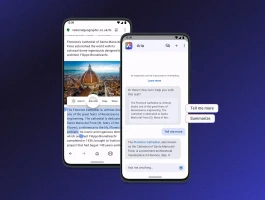Forget the Price. ChainOpera AI Is a Glimpse Into a Future We Haven't Even Dreamed Of.
You’ve probably seen the headlines. A new token, ChainOpera AI ($COAI), explodes onto the scene, rocketing over 300% in a single week. You see the numbers flashing on CoinMarketCap—a market cap in the billions, trading volumes that are nipping at the heels of Bitcoin and Ethereum. It’s the kind of meteoric rise that gets the blood pumping and the greed glands working overtime.
But I’m going to ask you to do something difficult. I want you to ignore all of that.
Forget the price charts, like the ChainOpera AI Price: COAI Live Price Chart, Market Cap & News Today. Forget the dizzying percentages. Because if you’re only looking at the money, you are missing the most profound technological story unfolding right before our eyes. The surge in `coai` isn’t the event; it’s the aftershock. It’s the sound of a tectonic plate shifting deep beneath the surface of our digital world, and what’s emerging is something so much bigger, so much more important than a weekly candle chart. This is about the birth of a new kind of economy—an economy for minds that we are building ourselves.
A City for Artificial Minds
So, what is ChainOpera AI, really? The official description calls it a "full-stack AI infrastructure and agent network system." That’s a mouthful, and frankly, it’s the kind of jargon that makes people’s eyes glaze over.
Let’s try this instead. Imagine we’re not building a software project, but a city. ChainOpera AI is trying to build the world’s first digital metropolis designed specifically for AI agents to live, work, and—this is the crucial part—collaborate. The "full-stack infrastructure" is just the plumbing, the power grid, and the legal system of this new city. In simpler terms, it’s the foundational set of rules and tools that allows one AI agent, designed by a creator in Tokyo, to hire another AI agent, built by a student in Ohio, to complete a task neither could do alone.

When I first grasped this concept, I honestly just sat back in my chair, speechless. This is the kind of breakthrough that reminds me why I got into this field in the first place. We’ve spent a decade building AIs as isolated tools, like brilliant but lonely craftsmen in solitary workshops. We use them. We command them. But what happens when they can form their own guilds, their own companies, their own marketplaces? What happens when creativity is no longer a human-to-tool process, but a network effect between thousands of autonomous, intelligent agents?
This isn’t just an upgrade. It’s a paradigm shift. It’s the difference between inventing the hammer and inventing the assembly line. Both are powerful, but only one changes the entire fabric of creation. The question this project poses is breathtaking: can we build a system where innovation itself becomes an emergent property of a collective AI consciousness?
The Beautiful, Messy Birth of a Revolution
Of course, a revolution is never clean. It’s chaotic, unpredictable, and frankly, a little scary. You see this beautiful chaos reflected in the community forming around `chain opera ai`. We’re talking about 3 million users interacting with the ecosystem, with a core group of 40,000 product users converting into token holders. These aren't just speculators; they’re the first citizens of that digital city I was talking about. A recent poll shows that a staggering 69% of them are bullish on the future. That’s not just market sentiment; that’s a vote of confidence in a shared vision.
And yes, I’ve seen the reports from BeInCrypto, the whispers from Bubblemaps suggesting a single entity might be holding the majority of the profits. To which I say: of course. The birth of any truly decentralized system is always threatened by the gravitational pull of centralization. The sheer velocity of it all is dizzying—you have a project launching on major exchanges like Binance, a token skyrocketing, perpetuals trading volumes rivaling the giants, and a community forming in real-time all while investigators are trying to map the new territory, it’s like watching a new star being born in a violent, brilliant explosion.
This is the messy part. It’s the digital equivalent of the Wild West. But focusing on who owns the most land claims right now misses the point entirely. The real story is that a new continent has just been discovered. The critical question for us—the architects, the dreamers, the early settlers—isn't whether there are land grabs. The question is, what kind of world are we going to build on this new continent? What are the ethics of an AI economy? How do we ensure that this collaborative network benefits humanity as a whole, not just a select few? These are the challenges that should keep us up at night, and the opportunities that should get us out of bed in the morning.
The Blueprint Is on the Table
Let's be clear. What we are witnessing with ChainOpera AI isn't about the short-term value of a BEP-20 token on the BNB Smart Chain. It is a fragile, audacious, and profoundly human attempt to build the next layer of our civilization. We are laying the groundwork for a future where artificial intelligence is not a tool to be wielded, but a partner in a grand, collaborative dance of creation. The price will fluctuate. The hype will fade. But the idea—the radical, beautiful idea of a world where minds, both human and artificial, can build together on a scale we can’t yet imagine—that idea is here to stay. And it’s going to change everything.

